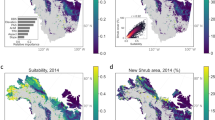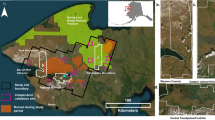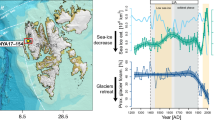Abstract
Arctic tundra has experienced rapid warming, outpacing global averages, leading to significant greening whose primary drivers include widespread shrubification. Here we confirm that a fire–greening positive feedback loop is evident across the Alaskan tundra, and evidence suggests that this feedback loop is dominated by the fire–shrub interactions. We show that tundra wildfires, especially those with higher severity, play a critical role in boosting the overall greening of the tundra, often by enhancing upright deciduous shrub growth or establishment but sometimes by inducing increases in other vascular biomass. In addition, fire–greening interactions vary greatly within different tundra subregions, a likely consequence of the spatial heterogeneity in vegetation composition, climatic and geophysical conditions.
This is a preview of subscription content, access via your institution
Access options
Access Nature and 54 other Nature Portfolio journals
Get Nature+, our best-value online-access subscription
$32.99 / 30 days
cancel any time
Subscribe to this journal
Receive 12 digital issues and online access to articles
$119.00 per year
only $9.92 per issue
Buy this article
- Purchase on SpringerLink
- Instant access to full article PDF
Prices may be subject to local taxes which are calculated during checkout


Similar content being viewed by others
Data availability
All data used in this paper are publicly accessible. The field data that our team collected are available through the Oak Ridge National Laboratory Distributed Active Archive Center (ORNL DAAC) at https://doi.org/10.3334/ORNLDAAC/1919. The AKVEG is available at https://akveg.uaa.alaska.edu/. The MTBS product is available at https://www.mtbs.gov/. The CAVM dataset is available at https://www.geobotany.uaf.edu/cavm/. The LandsatTS package for R is available via GitHub at https://github.com/logan-berner/LandsatTS. Visualizations in this paper were implemented using ArcGIS Desktop (v10.6), and R (v3.5.1). Data analyses were carried out using R (v3.5.1), Python (v2.7.14), IDL (v8.5) and GEE.
References
Arctic Climate Change Update 2021: Key Trends and Impacts. Summary for Policy-Makers 16 (AMAP, 2021).
Berner, L. T. et al. Summer warming explains widespread but not uniform greening in the Arctic tundra biome. Nat. Commun. 11, 4621 (2020).
Elmendorf, S. C. et al. Plot-scale evidence of tundra vegetation change and links to recent summer warming. Nat. Clim. Change 2, 453–457 (2012).
Sturm, M., Racine, C. & Tape, K. Climate change: increasing shrub abundance in the Arctic. Nature 411, 546–547 (2001).
Mekonnen, Z. A. et al. Arctic tundra shrubification: a review of mechanisms and impacts on ecosystem carbon balance. Environ. Res. Lett. 16, 053001 (2021).
Myers-Smith, I. H. et al. Shrub expansion in tundra ecosystems: dynamics, impacts and research priorities. Environ. Res. Lett. 6, 045509 (2011).
Stow, D. A. et al. Remote sensing of vegetation and land-cover change in Arctic tundra ecosystems. Remote Sens. Environ. 89, 281–308 (2004).
Pearson, R. G. et al. Shifts in Arctic vegetation and associated feedbacks under climate change. Nat. Clim. Change 3, 673–677 (2013).
Sistla, S. A. et al. Long-term warming restructures Arctic tundra without changing net soil carbon storage. Nature 497, 615–618 (2013).
Blok, D. et al. Shrub expansion may reduce summer permafrost thaw in Siberian tundra. Glob. Change Biol. 16, 1296–1305 (2010).
Loranty, M. M., Goetz, S. J. & Beck, P. S. A. Tundra vegetation effects on pan-Arctic albedo. Environ. Res. Lett. 6, (2011).
Mack, M. C. et al. Carbon loss from an unprecedented Arctic tundra wildfire. Nature 475, 489–492 (2011).
French, N. H. F., Whitley, M. A. & Jenkins, L. K. Fire disturbance effects on land surface albedo in Alaskan tundra. J. Geophys. Res. Biogeosci. 121, 841–854 (2016).
Hewitt, R. E., Hollingsworth, T. N., Stuart Chapin Iii, F. & Lee Taylor, D. Fire-severity effects on plant–fungal interactions after a novel tundra wildfire disturbance: implications for arctic shrub and tree migration. BMC Ecol. 16, 25 (2016).
Higuera, P. E. et al. Frequent fires in ancient shrub tundra: implications of paleorecords for arctic environmental change. PLoS ONE 3, e0001744 (2008).
Hu, F. S. et al. Arctic tundra fires: natural variability and responses to climate change. Front. Ecol. Environ. 13, 369–377 (2015).
French, N. H. F. et al. Fire in arctic tundra of Alaska: past fire activity, future fire potential, and significance for land management and ecology. Int. J. Wildland Fire 24, 1045–1061 (2015).
Higuera, P. E., Chipman, M. L., Barnes, J. L., Urban, M. A. & Hu, F. S. Variability of tundra fire regimes in Arctic Alaska: millennial-scale patterns and ecological implications. Ecol. Appl. 21, 3211–3226 (2011).
Gaglioti, B. V. et al. Tussocks enduring or shrubs greening: alternate responses to changing fire regimes in the Noatak River Valley, Alaska. J. Geophys. Res. Biogeosci. 126, e2020JG006009 (2021).
Chen, Y., Hu, F. S. & Lara, M. J. Divergent shrub-cover responses driven by climate, wildfire, and permafrost interactions in Arctic tundra ecosystems. Glob. Change Biol. 27, 652–663 (2021).
Fastie, C. L., Lloyd, A. H. & Doak, P. Fire history and postfire forest development in an upland watershed of interior Alaska. J. Geophys. Res. Atmos. 108, (2002).
Mack, M. C., Schuur, E. A. G., Bret-Harte, M. S., Shaver, G. R. & Chapin, F. S. Ecosystem carbon storage in arctic tundra reduced by long-term nutrient fertilization. Nature 431, 440–443 (2004).
Racine, C., Jandt, R., Meyers, C. & Dennis, J. Tundra fire and vegetation change along a hillslope on the Seward Peninsula, Alaska, U.S.A. Arct. Antarct. Alp. Res. 36, 1–10 (2004).
Higuera, P. E., Brubaker, L. B., Anderson, P. M., Hu, F. S. & Brown, T. A. Vegetation mediated the impacts of postglacial climate change on fire regimes in the south-central Brooks Range, Alaska. Ecol. Monogr. 79, 201–219 (2009).
Bailey, A. W. & Anderson, M. L. Fire temperatures in grass, shrub and aspen forest communities of Central Alberta. J. Range Manag. Arch. 33, 37–40 (1980).
Berner, L. T., Jantz, P., Tape, K. D. & Goetz, S. J. Tundra plant above-ground biomass and shrub dominance mapped across the North Slope of Alaska. Environ. Res. Lett. 13, 035002 (2018).
Blok, D. et al. The response of Arctic vegetation to the summer climate: relation between shrub cover, NDVI, surface albedo and temperature. Environ. Res. Lett. 6, 035502 (2011).
Tape, K. E. N., Sturm, M. & Racine, C. The evidence for shrub expansion in Northern Alaska and the Pan-Arctic. Glob. Change Biol. 12, 686–702 (2006).
Cunliffe, A. M. et al. Aboveground biomass corresponds strongly with drone-derived canopy height but weakly with greenness (NDVI) in a shrub tundra landscape. Environ. Res. Lett. 15, 125004 (2020).
Bret-Harte, M. S. et al. The response of Arctic vegetation and soils following an unusually severe tundra fire. Philos. Trans. R. Soc. B 368, 20120490 (2013).
Racine, C. H., Johnson, L. A. & Viereck, L. A. Patterns of vegetation recovery after tundra fires in Northwestern Alaska, U.S.A. Arct. Alp. Res. 19, 461–469 (1987).
Nawrocki, T. W. et al. Alaska Vegetation Plots (AKVEG) database. https://akveg.uaa.alaska.edu/ (University of Alaska Anchorage, 2022).
Rocha, A. V. et al. The footprint of Alaskan tundra fires during the past half-century: implications for surface properties and radiative forcing. Environ. Res. Lett. 7, 044039 (2012).
Walker, D. A. et al. The Circumpolar Arctic Vegetation Map. J. Veg. Sci. 16, 267–282 (2005).
Hu, F. S. et al. Tundra burning in Alaska: linkages to climatic change and sea ice retreat. J. Geophys. Res. Biogeosci. 115, (2010).
Heijmans, M. M. P. D. et al. Tundra vegetation change and impacts on permafrost. Nat. Rev. Earth Environ. 3, 68–84 (2022).
Zhu, X. et al. A synthesized field survey database of vegetation and active-layer properties for the Alaskan tundra (1972–2020). Earth Syst. Sci. Data 16, 3687–3703 (2024).
Field data collection protocol for the Alaska Vegetation Map Version 1.0. AGC VWG https://agc-vegetation-soa-dnr.hub.arcgis.com/ (2024).
Eidenshink, J. C. et al. A project for monitoring trends in burn severity. Fire Ecol. 3, 3–21 (2007).
Miller, J. D. & Thode, A. E. Quantifying burn severity in a heterogeneous landscape with a relative version of the delta normalized burn ratio (dNBR). Remote Sens. Environ. 109, 66–80 (2007).
Pekel, J.-F., Cottam, A., Gorelick, N. & Belward, A. S. High-resolution mapping of global surface water and its long-term changes. Nature 540, 418–422 (2016).
Berner, L. T., Assmann, J. J., Normand, S. & Goetz, S. J. ‘LandsatTS’: an R package to facilitate retrieval, cleaning, cross-calibration, and phenological modeling of Landsat time series data. Ecography 2023, e06768 (2023).
Muller, S., Walker, D. A. & Jorgenson, M. T. Land Cover and Ecosystem Map Collection for Northern Alaska. https://doi.org/10.3334/ORNLDAAC/1359 (ORNL Distributed Active Archive Center, 2018).
Raynolds, M. K. et al. A raster version of the Circumpolar Arctic Vegetation Map (CAVM). Remote Sens. Environ. 232, 111297 (2019).
Kasischke, E. S., Williams, D. & Barry, D. Analysis of the patterns of large fires in the boreal forest region of Alaska. Int. J. Wildland Fire 11, 131–144 (2002).
Smith, W. B. & Brand, G. J. Allometric Biomass Equations for 98 Species of Herbs, Shrubs, and Small Trees (US Department of Agriculture, 1983).
Acknowledgements
This study was funded by NASA ABoVE and was supported by the NASA Terrestrial Ecology programme grant NNX15AT79A (T.V.L.).
Author information
Authors and Affiliations
Contributions
D.C.: conceptualization, methodology, software, data curation, field work, writing – original draft, writing – review and editing, visualization and project administration. C.F.: methodology and software. L.K.J.: field work. J.H.: field work and writing – review and editing. Z.W.: methodology and software. R.R.J.: writing – review and editing. G.V.F.: writing – review and editing. A.B.: writing – original draft, and writing – review and editing. L.T.B.: writing – review and editing. T.V.L.: field work, writing – review and editing, project administration and funding acquisition.
Corresponding author
Ethics declarations
Competing interests
The authors declare no competing interests.
Peer review
Peer review information
Nature Plants thanks the anonymous reviewers for their contribution to the peer review of this work.
Additional information
Publisher’s note Springer Nature remains neutral with regard to jurisdictional claims in published maps and institutional affiliations.
Extended data
Extended Data Fig. 1 Distribution of field sites and the four tundra subregions.
The boundary of the Arctic tundra is delineated based on the Circumpolar Arctic Vegetation Map34 (CAVM). Historical fire perimeters (red) are based on the Alaska Large Fire Database45 from 1940 to 2021. Field data in Seward and Noatak were collected by our team, which are available at https://doi.org/10.3334/ORNLDAAC/1919.
Extended Data Fig. 2 Distribution of random sample points generated across the Alaskan tundra.
Red, green, and blue points represent burned, unburned, and background sites, respectively. Panel (a) shows an overall view across the Alaskan tundra, while panels (b) and (c) offer close-up views of two specific locations.
Extended Data Fig. 3 The distribution of AKVEG field points.
The distribution of the tundra field points that the Alaska Vegetation Plots Database (AKVEG)32 contains.
Extended Data Fig. 4 Scatterplots of field-measured shrub and graminoid cover and NDVImax by years since fire based on Landsat imagery on GEE.
a–l, Panels correspond to tundra subregions North Slope (a–c), Noatak (d–f), Seward (g–i), and Southwest (j–l). m–o, Panels correspond to all of the Alaskan tundra. Symbols ‘*’ and ‘**’ after the correlation (R) values correspond to p < 0.01 and 0.001, respectively. Field data were from AKVEG. DS: deciduous shrub; ES: evergreen shrub; GD: graminoid.
Extended Data Fig. 5 Mean biomass of four dominant shrub species for each stand age group calculated based on 1 x 1m plots in Noatak (a) and Seward (b).
YSF: year since fire. Birch: Betula nana; Blueberry: Vaccinium uliginosum; Ledum: Rhododendron groenlandicum (bog Labrador tea); Salix: Salix spp. Error bars denote ±1 standard error. Crosses represent the values of the mean biomass. The actual data, including the numbers of observations, are listed in Supplementary Table 2.
Extended Data Fig. 6 Post-fire NDVImax anomaly trajectories for different physiognomic types and for high severity level burned points.
Post-fire NDVImax anomaly trajectories for different physiognomic types (according to the 1 km CAVM raster dataset44) and for high severity level burned points. a–d, Tundra subregions North Slope (a), Noatak (b), Seward (c) and Southwest (d). Error bars denote ±1 standard error. The pie charts on the right show the relative proportions of the different physiognomic types among all high severity burned points in the corresponding subregion. The actual data, including the numbers of observations, are listed in Supplementary Table 3 (the trajectories) and Supplementary Table 4 (the pie charts), respectively.
Extended Data Fig. 7 Proportions of mean total biomass of four dominant shrub species for each stand age group calculated based on 1 x 1m plots in Noatak (a) and Seward (b).
YSF: year since fire. Birch: Betula nana; Blueberry: Vaccinium uliginosum; Ledum: Rhododendron groenlandicum (bog Labrador tea); Willow: Salix spp. Error bars denote ±1 standard error. Crosses represent the values of the mean biomass. The actual data, including the numbers of observations, are listed in Supplementary Table 5.
Extended Data Fig. 8 NDVImax trajectories between 2001 and 2021 based on matching burned and background sample points.
a–d, Panels correspond to tundra subregions North Slope (a), Noatak (b), Seward (c) and Southwest (d). Error bars denote ±1 standard error. The actual data, including the numbers of observations, are listed in Supplementary Table 6.
Supplementary information
Supplementary Information
Supplementary Tables 1–6.
Rights and permissions
Springer Nature or its licensor (e.g. a society or other partner) holds exclusive rights to this article under a publishing agreement with the author(s) or other rightsholder(s); author self-archiving of the accepted manuscript version of this article is solely governed by the terms of such publishing agreement and applicable law.
About this article
Cite this article
Chen, D., Fu, C., Jenkins, L.K. et al. Regional fire–greening positive feedback loops in Alaskan Arctic tundra. Nat. Plants 10, 1886–1891 (2024). https://doi.org/10.1038/s41477-024-01850-5
Received:
Accepted:
Published:
Issue date:
DOI: https://doi.org/10.1038/s41477-024-01850-5
This article is cited by
-
Delayed formation of Arctic snow cover in response to wildland fires in a warming climate
Nature Climate Change (2025)



